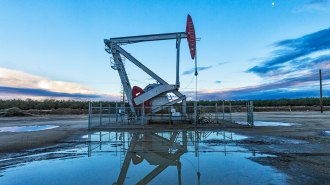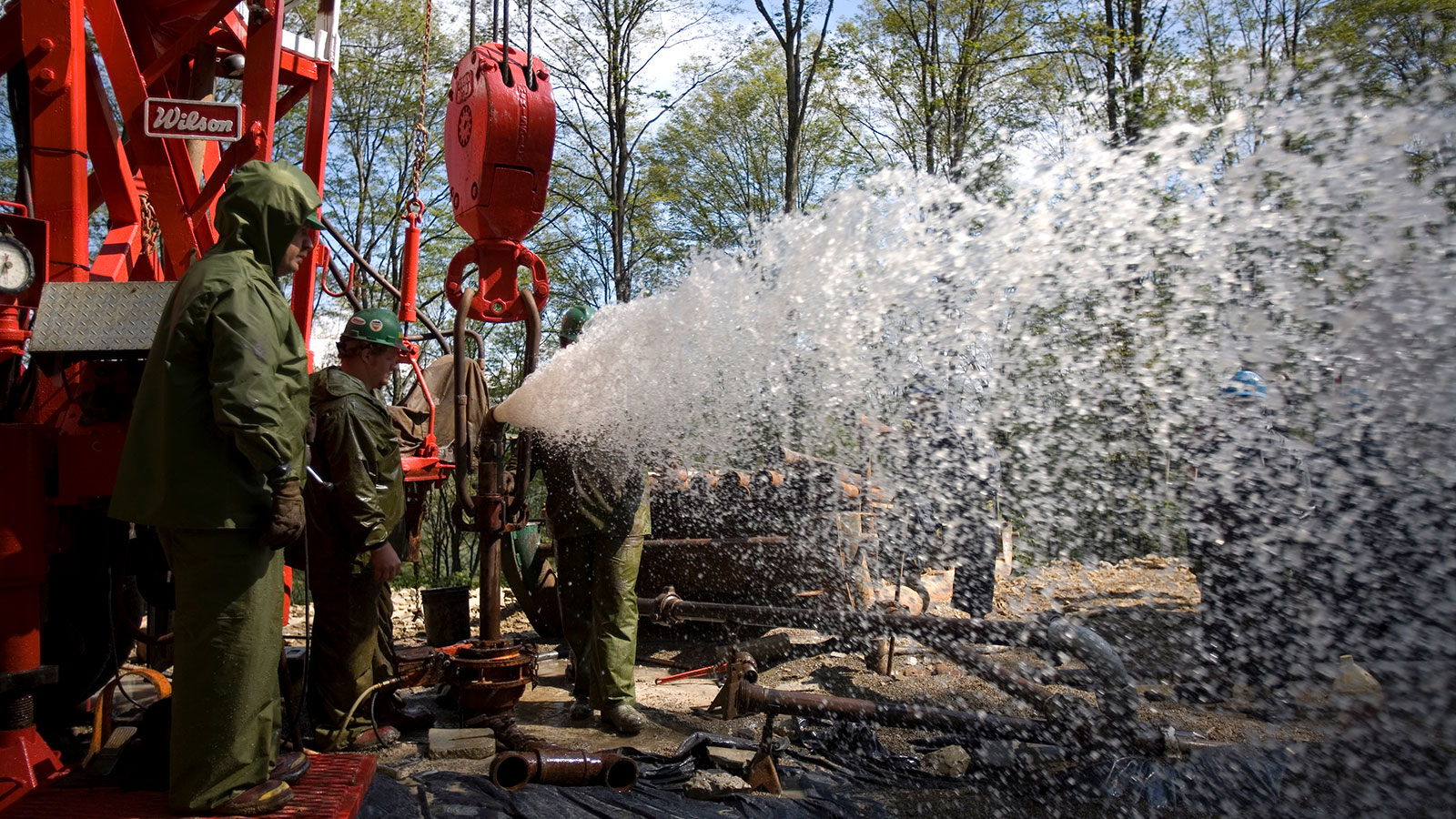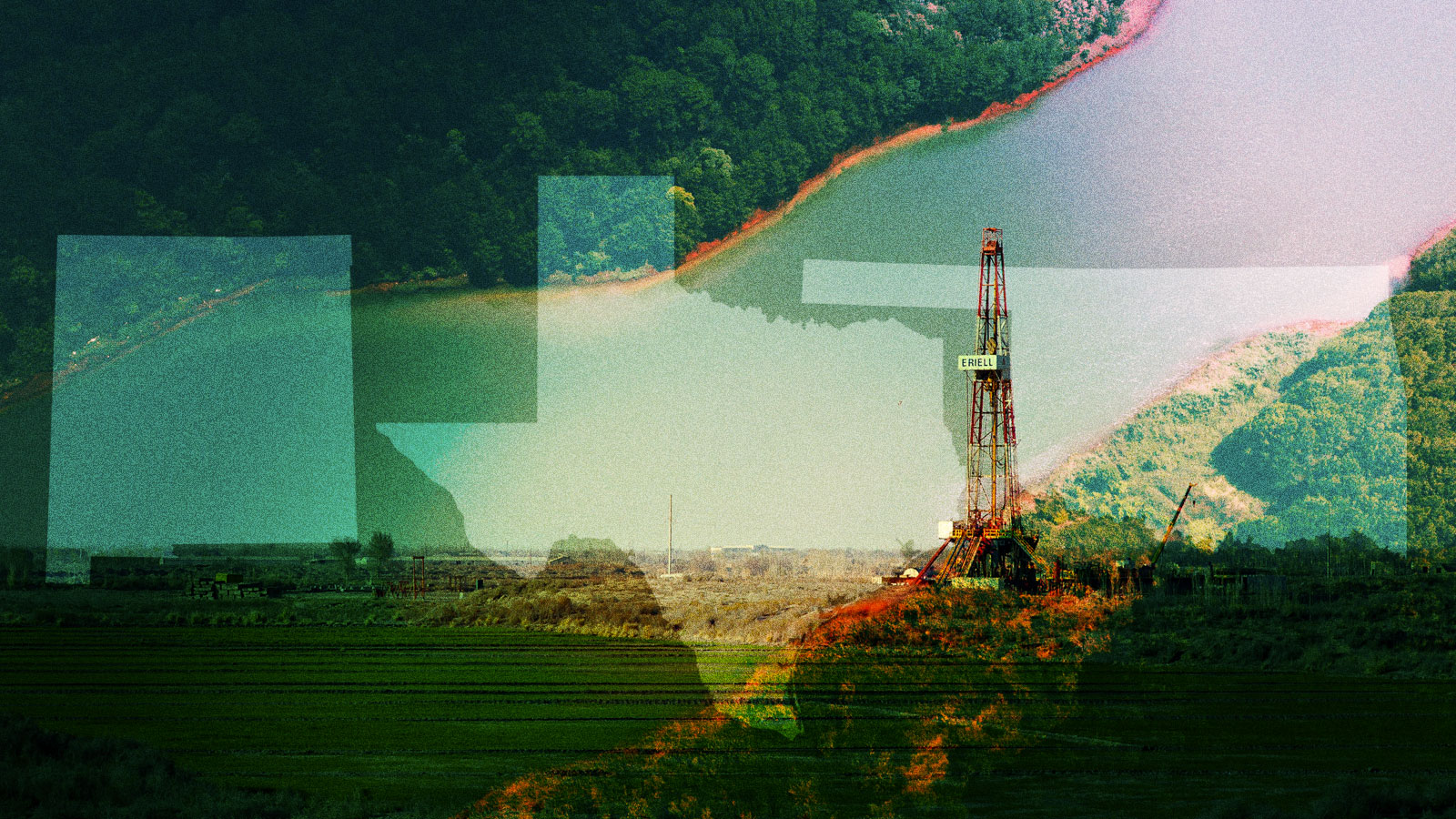For more than six months, twin brothers Ronald and Donald Schweitzer have watched large amounts of salty wastewater bubble up from the ground in their wheat field. The “saltwater purge” has killed three trees and several acres of crops on their northwest Oklahoma farm.
“Absolutely ruined,” Ronald Schweitzer told a local TV station. “It won’t grow nothing, not unless they dig the dirt out and put new dirt back in.”
The Schweitzers’ property is surrounded by highly-pressurized underground injection wells that store wastewater from oil and gas drilling. After tests confirmed that the saltwater had a similar chemical profile to wastewater dumped in the area, the Oklahoma Corporation Commission shut down eight disposal wells and reduced pumping rates for several more in November. The agency, which regulates the oil and gas industry in the state, has also banned new wells in a 14,000-square-mile area near the Schweitzers’ field.
The industry generates mind-boggling quantities of this waste, which is called “produced water” in industry parlance. Oklahoma, Texas, and New Mexico producers alone generated about 270 billion gallons of it in 2017. That’s enough water to fill the New York Giants stadium more than 550 times over.
As oil and gas producers face increasing regulation of underground wastewater disposal — in part to limit earthquakes that result from the pressure injection puts on rocks — they’re looking for new ways to get rid of the fluid left behind after fracking and drilling. That pinch is being felt particularly acutely in Oklahoma, Texas, and New Mexico, which have experienced a fracking boom in the last few years and have limited ways to dispose of the substance.
Much to the alarm of environmentalists and public health experts, those three states are now exploring expanding avenues for produced water disposal — including discarding the wastewater in streams and rivers.
A complex web of rules govern produced water management. East of the 98th meridian — an imaginary line that runs down the middle of Kansas, Oklahoma, and Texas — oil and gas operators are allowed to release treated wastewater into rivers, but only if it’s first routed through treatment facilities capable of removing the chemicals contained in the waste.
West of the meridian, which includes half of Texas and Oklahoma as well as all of New Mexico, oil and gas companies can discard produced water into rivers without that hurdle, so long as they secure government permits. In the three Southwestern states at the heart of the country’s oil boom, the Environmental Protection Agency is currently responsible for issuing permits. Producers say this makes them time-consuming and cumbersome to obtain. As a result, last year Texas and Oklahoma took steps to take over permitting from the EPA. New Mexico is considering following suit.
The EPA has also been considering easing regulations — including the 98th meridian rule — which could further expand the industry’s wastewater disposal options. The agency is set to publish a final report with its findings in the next few months.
The oil and gas industry has been a vocal proponent of expanding disposal methods. They say that few options exist to manage produced water and that current regulations limit the industry’s ability to extract oil and gas. The rule banning companies from dumping wastewater into rivers east of the 98th meridian without first sending it through centralized treatment systems is arbitrary, according to the industry. They also consider it unfair that downstream industries such as petrochemical refineries can discharge wastewater into rivers without the same regulatory requirements.
In a letter to the EPA, a coalition of industry groups including the American Petroleum Institute said that the agency was using “arbitrary geographic distinctions” and that it should move quickly to develop regulations that would allow the industry to more efficiently treat and discharge its own wastewater into rivers and streams east of the 98th meridian.
Produced water contains a slew of chemicals, many of which are poorly understood. Without clear knowledge of the types of chemicals in wastewater —let alone their toxicity — disposal in rivers and streams is reckless, environmental groups and public health researchers say, and could have severe ecological and health ramifications.
“If you haven’t done the target science-based research to make changes to your standards and monitoring tools, there’s a real risk that our water resources, our public health, and environment could be negatively impacted,” said Nichole Saunders, a senior attorney at the Environmental Defense Fund, an environmental nonprofit.
“We aren’t going to find what we aren’t looking for.”
Known and unknown

The oil and gas industry produces billions of gallons of wastewater every year. Citizens of the Planet / Education Images / Universal Images Group via Getty Images
The volume of produced water generated in oilfields has risen dramatically in recent years, with no signs of slowing. In Texas, the top producer of wastewater in the country, produced water volume skyrocketed by 25 billion gallons between 2014 and 2017. The increase is primarily from the Permian Basin — a shale formation that straddles West Texas and southeastern New Mexico — which has been at the heart of the fracking boom. About half of all oil produced in the country is from the Permian, and Sourcewater, Inc., an oil and gas intelligence data firm, projects that Texas alone will generate 630 billion gallons of produced water by 2023.
Produced water is generated both during conventional drilling and fracking. There are two main sources of wastewater in oilfields: water comingled with oil and gas trapped underground and water mixed with sand and chemicals used for fracking. Depending on the particular geologic formation of an extraction site as well as the substances used in the extraction process, these waters can contain hundreds of toxic chemicals and metals, including benzene, lead, and radium.
The vast majority of produced water is currently dumped back underground into cavernous reservoirs called injection wells. But in the last decade, these wells have been linked to earthquakes. In Oklahoma, earthquakes have increased 900-fold since 2008, when fracking became more prevalent. In the last few years, the state has instituted a number of regulations to limit the amount of wastewater disposed, helping decrease the pressure in underground wells. Those rules have led to a sharp decline in earthquakes, but they have left oil and gas producers scrambling to find new and cheap ways to dispose of the fluid.
Environmental advocates and public health researchers say that the biggest concern with releasing produced water into rivers and streams is that the consequences are not very well understood. Oilfield wastewater contains a large but unknown number of chemicals, and there’s a dearth of research characterizing its components, concentration, and the effects it can have on public health and the environment, scientists say.
Last year, the Environmental Defense Fund conducted a review of the scientific literature and found that 86 percent of the nearly 1,200 chemicals identified in produced water didn’t have the necessary data available to determine exposure levels that would harm humans.
“The [science] gaps are big,” said Saunders, the EDF attorney. “You have to understand what chemicals are there, and know if they’re going to cause harm if they’re released — and know what the right levels are.”
The quality of produced water is also highly dependent on the geology and history of the formation from which it comes. No two formations are the same, and the type and quantity of chemicals present are highly variable, sometimes differing significantly within the same oilfield and over time. As a result, research about produced water in one field is not necessarily applicable to another.
“To be talking about produced water as a singular thing is an oversimplification,” said Seth Shonkoff, executive director of PSE Healthy Energy, an energy science and policy institute, and a visiting scholar at the University of California, Berkeley. Companies inject a number of corrosion inhibitors, biocides, and friction reducers during fracking and drilling, and many of these chemicals react with one another and break down into “daughter products,” Shonkoff said.
“If we’re only testing for the compounds that we know are being used, we’re not able to actually sense whether there are other chemicals that might be of concern,” he added.
Shonkoff is a member of a food safety panel convened by the Central Valley Regional Water Quality Control Board, a water regulator in California’s San Joaquin Valley. Produced water has been treated and used for irrigation in the Central Valley for more than three decades. In 2017, wastewater was used to farm about 90,000 acres of cropland, according to the board. So far, studies of the crops grown with produced water do not indicate any public health concerns, but Shonkoff said those studies have been limited in number and scope.
Produced water in the region is also somewhat unique, Shonkoff said, and results from California should not be used to justify new disposal options in Texas or Oklahoma. The geologic formations in the region have a freshwater history as opposed to a marine history, which led to unusually low salt content in its groundwater. As a result, the total dissolved solids — a measure of salt content in liquids — in some Central Valley oil fields is as low as 300 parts per million, compared to values in the hundreds of thousands in southwestern states. That makes it easier to treat.
“I certainly wouldn’t drag scientific findings from these two super weirdo oil fields in California over to Texas or New Mexico and say that I had a good body of information to make a sound policy decision,” he said.

Pennsylvania has seen unprecedented levels of extraction thanks to the Marcellus shale, but it has few options to dispose of wastewater from fracking. Robert Nickelsberg / Getty Images
Lessons from Pennsylvania
The flip side of California’s relatively sunny experience dumping wastewater into its water supply can be found in Pennsylvania. The state has seen unprecedented levels of oil and gas extraction thanks to the Marcellus shale formation, but it has few options to dispose of the toxic fluids produced during fracking. The particularities of Pennsylvania’s geologic formations make underground disposal largely unfeasible, forcing oil and gas producers to either truck it over state lines to Ohio or send it to municipal and commercial treatment plants so it can be discharged into rivers.
During the early years of the fracking boom in Pennsylvania, the use of municipal sewage plants to treat produced water led to disastrous results. These plants struggled to handle the vast array of organic chemicals in the wastewater and ultimately discharged partially-treated water with high levels of heavy metals and salts into rivers.
In western Pennsylvania, for instance, sewage plants released wastewater containing bromide into the Monongahela River. This bromide-laced water was picked up by a municipal water treatment system downstream, where it reacted with chlorine disinfectants to form trihalomethanes, a cancer-causing chemical. The water was then distributed to homes. Once discovered, towns that relied on water from the river were advised to drink bottled water, and, in 2011, the state environmental agency asked companies to voluntarily refrain from sending produced water to sewage plants. The EPA officially banned the practice in 2016.
The industry still releases produced water into rivers in Pennsylvania, albeit after sending the fluids through so-called centralized wastewater facilities, commercial treatment plants built to handle oil and gas waste. According to a 2018 EPA report, there are eight such facilities in the state. The Pennsylvania Department of Environmental Protection permits them to release about 1.6 million gallons of wastewater per day.
There are signs that these facilities aren’t cleaning up the waste to particularly high standards. Researchers have found high levels of radium, a radioactive element that increases the risk of different types of cancer, downstream of the facilities’ outlets. Studies by researchers at Pennsylvania State University have found that radiation levels in the sediment at the outlet are up to 650 times higher than background levels.
“Even if you do treatment on these waters through these centralized treatment facilities, you’re still releasing water that has radium above levels typically found in freshwater — and you’re going to get accumulation in those sediments,” said Nancy Lauer, a science and policy fellow at Duke University. “When you’re releasing tons of that water every day consistently, you’re going to get pretty high accumulations. That’s been shown in Pennsylvania.”
That radium can also end up further downstream. A 2018 study found that mussels about a kilometer downstream of a treatment facility on the Allegheny River had higher strontium levels in their shells than those upstream, suggesting that the metal, which is present in oil and gas wastewater, was being carried downstream and absorbed by the bivalves.
“You need to do a perfect job to not have contamination from this practice,” said Lauer. “And that’s just looking at the radioactivity aspect.”
The 98th meridian
How and where an oil and gas producer can dispose produced water depends on which side of the 98th meridian they’re operating.
Releasing produced water into streams and rivers is allowed west of the 98th meridian, where water is scarce and treated produced water could help alleviate shortages. In the eastern half of the country, however, the practice is banned except when wastewater is treated through a centralized system, as in Pennsylvania.
“The 98th meridian runs right through the middle of some oil fields,” said Kinnan Golemon, an oil and gas lobbyist based in Austin, Texas. “You can treat [and release produced water] on one side of the oil field and you can’t on the other side. That’s stupid.”
EPA and state environmental agencies issue permits to oil and gas producers west of the 98th meridian, but few operators have applied for permits in Texas, New Mexico, and Oklahoma, since alternatives such as underground injection wells have so far proven the cheaper option. Jennah Durant, an EPA spokesperson, said that the agency has issued eight permits that are currently active for produced water disposal in Texas — and none in Oklahoma and New Mexico.
Golemon said that if regulatory roadblocks like the meridian rule and the EPA permitting process are eliminated, it will allow for technological innovation that could result in new treatment methods to improve the quality of produced water being discharged. Once acceptable standards for treatment are set by regulatory agencies, the industry will innovate, he said.
Texas already has wastewater treatment facilities capable of handling produced water, according to Todd Staples, president of the Texas Oil and Gas Association, an industry group. “Modern-day treatment systems in Texas are very good,” he said, and treated wastewater will “meet the quality of the watershed” as well as any established regulatory limits.
Texas, Oklahoma, and New Mexico’s oil and gas regulatory agencies are also broadly supportive of expanding disposal options for produced water, citing droughts, water availability issues, and the potential to augment river flows with recycled wastewater.
“Current perceived issues associated with discharge of treated produced water are not insurmountable,” a geologist with the Texas oil and gas regulator wrote in a letter to the EPA.
Environmental advocates don’t necessarily disagree with that statement. But to overcome those problems, a lot more research must first be conducted, they say.
“I’d like to see the research done before we make regulatory and permitting decisions,” said Saunders. “Because if we find something, we can’t take it back.”




